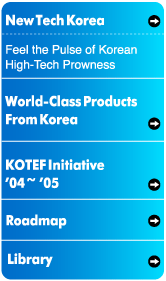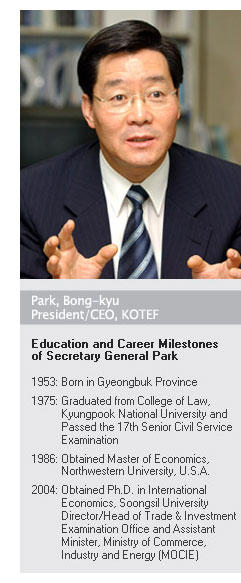
Published at Korea Herald Economy on March 30, 2005 |
|
| By Park Bong-Kyu, Secretary-General, Korea Industrial Technology Foundation (KOTEF) |
|
|
The same line of thought could be applied to government policies, corporate strategies and even individual life planning, since a proper balance must be maintained between a microscopic view that can analyze reality carefully and a telescopic view that can take the future into account. Regrettably, there have been points of weakness in our economic development process from the perspective of the 'Micro-Macro Balance.' The government has been busy resolving accumulated pending issues that it faces and enterprises also are occupied with investigating and providing what markets want as quickly as possible. Let's narrow our view to just enterprises. According to a survey conducted by KOTEF in 2003 on establishing technology strategies, while enterprises conducting information analyses of technology trends were 80% of the total surveyed, those that were attempting to make technology forecasts stood at just 20%. The survey results verify that our enterprises are oriented more toward the microscope than the telescope. Considering that the survey was conducted on comparatively future-oriented industries with vigorous technology development activities such as digital home appliances, robots and wireless communication devices, the situation in general industrial fields can be assumed to be even more imbalanced. As for such enterprise behavior, nevertheless, we cannot just criticize them for being 'nearsighted.' Since an enterprise is like an organic entity that adapts itself for survival, a strategy focused on phenomenon analysis is commonly accepted in the market and moreover enterprises only evolve in an environment in ways that they regard as most efficient. Now, however, they must change. Technology development and market change are accelerating amid mutual interaction. Understanding the present and the future of technology and markets and establishment of strategies based on this are becoming the factors that determine survival itself as well as success or failure. As for those enterprises that cannot accumulate sufficient capability to cope with the changing environment, it will be a very challenging struggle to survive. Against this backdrop, a very positive development is occurring that includes preparation of roadmaps predicting future environmental changes and suggesting technology development directions and specific implementation plans. The fact that the government is drawing big pictures, a national technology roadmap, industrial technology roadmap, parts and materials roadmap, etc., and sharing them with the private sector appears to be an attempt to focus the selective concentration of our limited resources. It is also worthwhile to note the private sector"s participation in the process with initiatives and a heightened awareness of the possibilities. Of course, there still is a 'Lack of 2%.' If goals are established after analyzing conditions with a microscope and forecasting the future with a telescope, detailed methods should be produced as to how to approach the problem, through which routes and by utilizing what means. In doing this, it is necessary to engage in 'Precision Processing,' using the microscope on the big pictures seen through the telescope. In other words, specific strategies and tasks should be developed for each respective route and stage. This is not a task that can be shouldered by the government alone. Reflecting environmental changes and policy promotion directions, the government must upgrade the roadmaps on a regular basis. Based on this, the parties concerned should move to draw detailed roadmaps again by industry, region and business sector. And enterprises must engage in precision processing after preparing the most appropriate roadmaps for themselves. The most useful methodology is planning roadmaps that utilize all available knowledge to the maximum extent with joint participation of interested parties, establishing goals after analyzing the situation, making future projections utilizing the analyses, suggesting specific and phased tasks and reviewing the processes continuously to apply corrections. |
|

 Although both the microscope and telescope are tools to observe nature using magnification, their usages are entirely different. The former is used to observe subjects that are close and the latter for those far away. Regarding the two similar but different tools, curiosity arises which is more important and which has contributed more to human development. However, this would be a foolish study, because we cannot ignore the significance of either of the two - observing nearby subjects more precisely and observing matter far away after bringing them closer to our eyes.
Although both the microscope and telescope are tools to observe nature using magnification, their usages are entirely different. The former is used to observe subjects that are close and the latter for those far away. Regarding the two similar but different tools, curiosity arises which is more important and which has contributed more to human development. However, this would be a foolish study, because we cannot ignore the significance of either of the two - observing nearby subjects more precisely and observing matter far away after bringing them closer to our eyes.